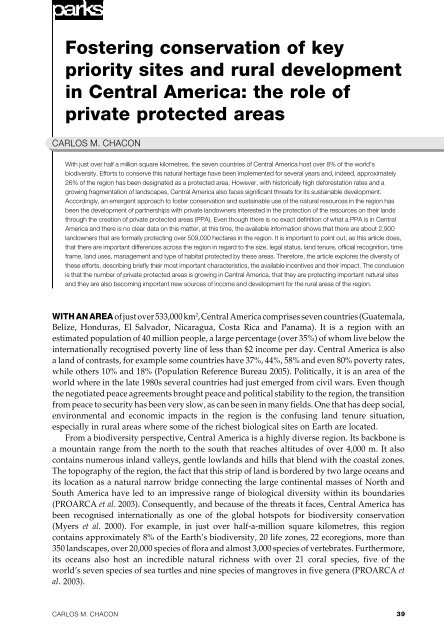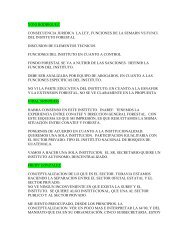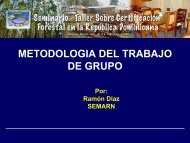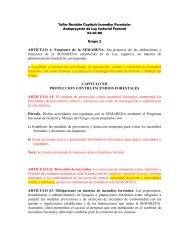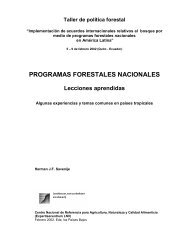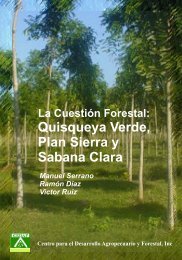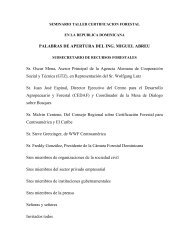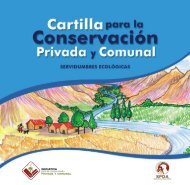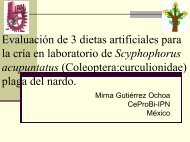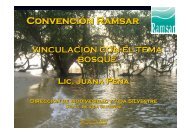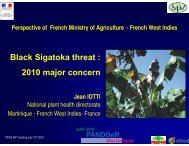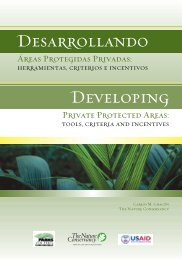Fostering conservation of key priority sites and rural ... - CEDAF
Fostering conservation of key priority sites and rural ... - CEDAF
Fostering conservation of key priority sites and rural ... - CEDAF
You also want an ePaper? Increase the reach of your titles
YUMPU automatically turns print PDFs into web optimized ePapers that Google loves.
<strong>Fostering</strong> <strong>conservation</strong> <strong>of</strong> <strong>key</strong><strong>priority</strong> <strong>sites</strong> <strong>and</strong> <strong>rural</strong> developmentin Central America: the role <strong>of</strong>private protected areasCARLOS M. CHACONWith just over half a million square kilometres, the seven countries <strong>of</strong> Central America host over 8% <strong>of</strong> the world’sbiodiversity. Efforts to conserve this natural heritage have been implemented for several years <strong>and</strong>, indeed, approximately26% <strong>of</strong> the region has been designated as a protected area. However, with historically high deforestation rates <strong>and</strong> agrowing fragmentation <strong>of</strong> l<strong>and</strong>scapes, Central America also faces significant threats for its sustainable development.Accordingly, an emergent approach to foster <strong>conservation</strong> <strong>and</strong> sustainable use <strong>of</strong> the natural resources in the region hasbeen the development <strong>of</strong> partnerships with private l<strong>and</strong>owners interested in the protection <strong>of</strong> the resources on their l<strong>and</strong>sthrough the creation <strong>of</strong> private protected areas (PPA). Even though there is no exact definition <strong>of</strong> what a PPA is in CentralAmerica <strong>and</strong> there is no clear data on this matter, at this time, the available information shows that there are about 2,900l<strong>and</strong>owners that are formally protecting over 509,000 hectares in the region. It is important to point out, as this article does,that there are important differences across the region in regard to the size, legal status, l<strong>and</strong> tenure, <strong>of</strong>ficial recognition, timeframe, l<strong>and</strong> uses, management <strong>and</strong> type <strong>of</strong> habitat protected by these areas. Therefore, the article explores the diversity <strong>of</strong>these efforts, describing briefly their most important characteristics, the available incentives <strong>and</strong> their impact. The conclusionis that the number <strong>of</strong> private protected areas is growing in Central America, that they are protecting important natural <strong>sites</strong><strong>and</strong> they are also becoming important new sources <strong>of</strong> income <strong>and</strong> development for the <strong>rural</strong> areas <strong>of</strong> the region.WITH AN AREA <strong>of</strong> just over 533,000 km 2 , Central America comprises seven countries (Guatemala,Belize, Honduras, El Salvador, Nicaragua, Costa Rica <strong>and</strong> Panama). It is a region with anestimated population <strong>of</strong> 40 million people, a large percentage (over 35%) <strong>of</strong> whom live below theinternationally recognised poverty line <strong>of</strong> less than $2 income per day. Central America is alsoa l<strong>and</strong> <strong>of</strong> contrasts, for example some countries have 37%, 44%, 58% <strong>and</strong> even 80% poverty rates,while others 10% <strong>and</strong> 18% (Population Reference Bureau 2005). Politically, it is an area <strong>of</strong> theworld where in the late 1980s several countries had just emerged from civil wars. Even thoughthe negotiated peace agreements brought peace <strong>and</strong> political stability to the region, the transitionfrom peace to security has been very slow, as can be seen in many fields. One that has deep social,environmental <strong>and</strong> economic impacts in the region is the confusing l<strong>and</strong> tenure situation,especially in <strong>rural</strong> areas where some <strong>of</strong> the richest biological <strong>sites</strong> on Earth are located.From a biodiversity perspective, Central America is a highly diverse region. Its backbone isa mountain range from the north to the south that reaches altitudes <strong>of</strong> over 4,000 m. It alsocontains numerous inl<strong>and</strong> valleys, gentle lowl<strong>and</strong>s <strong>and</strong> hills that blend with the coastal zones.The topography <strong>of</strong> the region, the fact that this strip <strong>of</strong> l<strong>and</strong> is bordered by two large oceans <strong>and</strong>its location as a natural narrow bridge connecting the large continental masses <strong>of</strong> North <strong>and</strong>South America have led to an impressive range <strong>of</strong> biological diversity within its boundaries(PROARCA et al. 2003). Consequently, <strong>and</strong> because <strong>of</strong> the threats it faces, Central America hasbeen recognised internationally as one <strong>of</strong> the global hotspots for biodiversity <strong>conservation</strong>(Myers et al. 2000). For example, in just over half-a-million square kilometres, this regioncontains approximately 8% <strong>of</strong> the Earth’s biodiversity, 20 life zones, 22 ecoregions, more than350 l<strong>and</strong>scapes, over 20,000 species <strong>of</strong> flora <strong>and</strong> almost 3,000 species <strong>of</strong> vertebrates. Furthermore,its oceans also host an incredible natural richness with over 21 coral species, five <strong>of</strong> theworld’s seven species <strong>of</strong> sea turtles <strong>and</strong> nine species <strong>of</strong> mangroves in five genera (PROARCA etal. 2003).CARLOS M. CHACON39
However, Central America faces serious threats to its rich natural heritage. In the 1990s itsdeforestation rate was 1.6% annually (380,000 ha per year) <strong>and</strong>, even though in the 2000–2005period it slowed down to about 1.3% (285,000 ha per year) (Mongabay.com 2005), the fact is thatat present only about 20% <strong>of</strong> the original natural vegetation remains (Myers et al. 2000).The most important threat to maintaining its rich natural heritage has been l<strong>and</strong> conversionfrom forests to agricultural use by private l<strong>and</strong>owners (individuals <strong>and</strong> corporations) <strong>and</strong>peasants (Faris, 1999). Indeed, in some countries pristine old-growth forest can only be foundwithin protected areas (PROARCA et al. 2003).Protected areas <strong>and</strong> existing <strong>conservation</strong> effortsThe threat <strong>of</strong> fragmentation <strong>of</strong> natural habitat as a consequence <strong>of</strong> the expansion <strong>of</strong> agriculture,the existence <strong>of</strong> <strong>key</strong> natural habitats in the region <strong>and</strong> the leadership <strong>of</strong> some individuals, privateenvironmental organisations <strong>and</strong> governments has resulted in the creation <strong>of</strong> over 550 protectedareas in Central America. These cover approximately 13 million hectares <strong>of</strong> natural habitatlocated on both public <strong>and</strong> private l<strong>and</strong>s (about 26% <strong>of</strong> the region) (PROARCA et al. 2003). Giventhe fact that in several cases these protected areas are becoming “isl<strong>and</strong>s” <strong>of</strong> natural habitatsurrounded by agriculture – cattle grazing, subsistence farming <strong>and</strong> large monoculture plantationsfor export – the countries <strong>of</strong> the region have also been working on the development <strong>of</strong> theMesoamerican Biological Corridor (MBC). The MBC stretches from southern Mexico to Panama,covering approximately 150,000 km 2 (53% <strong>of</strong> this area). It consists <strong>of</strong> a network <strong>of</strong> protected areas<strong>and</strong> buffer zones connected by local biological corridors with different uses <strong>and</strong> degrees <strong>of</strong>protection (UNDP/GEF 1999).The Campanario Park lies in the humid tropical Pacific lowl<strong>and</strong>s <strong>of</strong> the Osa Peninsula in Costa Rica.Photo: Carlos M. Chacon.40 PARKS Vol 15 No 2 PRIVATE PROTECTED AREAS 2005
The role <strong>of</strong> private <strong>conservation</strong>The l<strong>and</strong> tenure situation in Central America is very confusing because the l<strong>and</strong> registry systems<strong>of</strong> all the countries have recorded l<strong>and</strong> titles for only a small percentage <strong>of</strong> the territories withineach country, mostly in urban areas. However, in Central America there are no large publiclyowned territories. Most l<strong>and</strong>s are owned by private individuals, corporations, <strong>and</strong> local <strong>and</strong>indigenous communities. In addition, the legal status <strong>of</strong> those l<strong>and</strong>s is complicated because insome cases a person or community could have a clear l<strong>and</strong> title while in others they only have(or claim to have) possession rights after “occupying” those l<strong>and</strong>s for a number <strong>of</strong> years. Thus,when dealing with <strong>conservation</strong> <strong>and</strong> l<strong>and</strong> use issues, the fact is that the creation <strong>of</strong> protectedareas in Central America always involves the participation <strong>of</strong> people with property rights orclaims over the territories where the protected areas have been or are proposed to be created.On the other h<strong>and</strong>, the existing legal framework in the region limits the extent to which l<strong>and</strong>use restrictions on private property can be used to restrict l<strong>and</strong> use changes for <strong>conservation</strong>purposes. Private property rights are protected even at the constitutional level. Therefore, onlysome minor l<strong>and</strong> use restrictions on private property are permitted <strong>and</strong>, in many cases, propercompensation is required by the law or courts to be able to enforce them. In addition, l<strong>and</strong> userestrictions are not attractive from a social point <strong>of</strong> view because l<strong>and</strong>owners <strong>and</strong> communitiesoppose them. Therefore, given the governments’ lack <strong>of</strong> sufficient funding to compensateprivate l<strong>and</strong>owners, public authorities in the region must find ways to work with willing privatel<strong>and</strong>owners in the <strong>conservation</strong> <strong>of</strong> natural habitat.For these reasons, <strong>and</strong> the fact that the governments <strong>of</strong> the region have not had sufficientresources to develop <strong>and</strong> consolidate their national systems <strong>of</strong> protected areas, the involvement<strong>of</strong> environmental NGOs <strong>and</strong> individuals in this field has been very important over the years. Onthe one h<strong>and</strong>, many designated <strong>and</strong> proposed “public” protected areas contain large privateparcels within their boundaries. For example, in Costa Rica 11% <strong>of</strong> National Parks <strong>and</strong> 45% <strong>of</strong>Biological Reserves, National Monuments <strong>and</strong> Absolute Natural Reserves are still in privateh<strong>and</strong>s (MINAE/SINAC 2003). On the other h<strong>and</strong>, their buffer zones <strong>and</strong> proposed biologicalcorridors are located mostly on l<strong>and</strong>s owned or occupied by private individuals, indigenouspeoples <strong>and</strong> local communities.Accordingly, in Central America, several individuals <strong>and</strong> environmental organisations havebeen working for many years with the governments <strong>of</strong> the region on the promotion, designation<strong>and</strong> management <strong>of</strong> protected areas. Some examples are Defensores de la Naturaleza <strong>and</strong>Fundaeco in Guatemala, Belize Audubon Society in Belize, Amitigra in Honduras, Salvanaturain El Salvador <strong>and</strong> Fundación Cocibolca in Nicaragua (Proyecto para la consolidación delCorredor Biológico Mesoamericano 2003). Furthermore, some NGOs have been working onacquisition <strong>of</strong> private properties for <strong>conservation</strong> purposes. In some cases, they maintainownership <strong>and</strong> manage those l<strong>and</strong>s as private nature reserves while in others they transfer thosel<strong>and</strong>s to the governmental agency in charge <strong>of</strong> protected areas. Some <strong>of</strong> the previouslymentioned NGOs are also doing this type <strong>of</strong> work <strong>and</strong> other examples include TIDE in Belize,the National Parks Foundation, Tropical Science Center <strong>and</strong> Monteverde Conservation Leaguein Costa Rica, <strong>and</strong> ANCON in Panama.What is a private protected area (PPA) in Central America?Historically, the existence <strong>of</strong> private l<strong>and</strong>owners in natural areas has been seen as a threat to the<strong>conservation</strong> <strong>of</strong> pristine areas. Indeed, as described above, clearing <strong>and</strong> occupying vacant l<strong>and</strong>sby private individuals has been the driving force for the expansion <strong>of</strong> agriculture. However, agrowing number <strong>of</strong> private l<strong>and</strong>owners have demonstrated that they can also be good stewards<strong>of</strong> the resources they own or occupy. Some do it independently, creating their own de facto privatenature reserves, while others create formal private protected areas (PPA) working with theGovernments or the NGOs in the region.CARLOS M. CHACON41
So what is a PPA in Central America? For the purposes <strong>of</strong> this publication private protectedareas have been defined as: “A protected area managed by non-state entities–-including privatecorporations, associations, individuals <strong>and</strong> indigenous governments–-with legal interest in the l<strong>and</strong>, inwhole or in part. The protected area may be managed for private as well as public benefit, <strong>and</strong> the managingentities must be accountable to formal st<strong>and</strong>ards.”Looking at this definition, depending on what “the managing entities must be accountable t<strong>of</strong>ormal st<strong>and</strong>ards” means, information about PPAs existing in Central America could vary. In view<strong>of</strong> that definition <strong>of</strong> PPAs, there are two highly related issues: the definition <strong>of</strong> what a “formalst<strong>and</strong>ard” is <strong>and</strong> the source <strong>of</strong> those st<strong>and</strong>ards. If we use the definition <strong>of</strong> st<strong>and</strong>ard as “anacknowledged measure <strong>of</strong> comparison for quantitative or qualitative value” (Dictionary.com2005), then in Central America there are different types <strong>of</strong> st<strong>and</strong>ards for PPAs. They have beencreated by a few <strong>of</strong> the governments <strong>of</strong> the region, others by NGOs <strong>and</strong> some even by thel<strong>and</strong>owners themselves.In the case <strong>of</strong> Guatemala, Nicaragua, El Salvador <strong>and</strong> Costa Rica, the government agency incharge <strong>of</strong> the creation <strong>and</strong> management <strong>of</strong> their national systems <strong>of</strong> protected areas has issuedspecific regulations that provide the “formal st<strong>and</strong>ards” that private l<strong>and</strong>owners have to meetin order to obtain the <strong>of</strong>ficial PPA status they recognise. These st<strong>and</strong>ards oblige privatel<strong>and</strong>owners to comply with a number <strong>of</strong> requirements, such as the presentation <strong>of</strong> a detailedbiophysical report <strong>of</strong> the property, legal information (i.e. l<strong>and</strong> title) <strong>and</strong> a description <strong>of</strong> theproposed l<strong>and</strong> uses <strong>and</strong> <strong>conservation</strong> measures for their properties. In some cases the presentation<strong>and</strong> approval <strong>of</strong> a detailed management plan is required to obtain the designation <strong>of</strong> PPA.On the other h<strong>and</strong>, in all <strong>of</strong> the countries <strong>of</strong> the region there are networks <strong>of</strong> Private NatureReserves that represent a number <strong>of</strong> l<strong>and</strong>owners in their countries that are protecting all or part<strong>of</strong> their “reserves”. These NGOs have their own internal regulations/st<strong>and</strong>ards for theirmembers <strong>and</strong> to maintain their membership <strong>of</strong> the organisation they usually require thel<strong>and</strong>owner to sign an undertaking to conserve some <strong>of</strong> their l<strong>and</strong> for an undetermined period <strong>of</strong>time.The third course has been the definition <strong>of</strong> st<strong>and</strong>ards agreed contractually by two or morel<strong>and</strong>owners. These st<strong>and</strong>ards are normally in the form <strong>of</strong> a <strong>conservation</strong> easement or similarcontract, in which one <strong>of</strong> the parties is an environmental NGO implementing private l<strong>and</strong>s<strong>conservation</strong> programmes (known as “l<strong>and</strong> trusts”) <strong>and</strong> the other is a l<strong>and</strong>owner interested inlong-term <strong>conservation</strong> <strong>of</strong> all or part <strong>of</strong> their l<strong>and</strong>. A good example is CEDARENA in Costa Rica<strong>and</strong> the st<strong>and</strong>ards included in every <strong>conservation</strong> easement contract they sign with privatel<strong>and</strong>owners.Of course, all these types <strong>of</strong> “st<strong>and</strong>ards” vary across the region, <strong>and</strong> they also vary withineach country. Usually the st<strong>and</strong>ards established by the governments <strong>and</strong> NGOs are moredetailed than those adopted by the networks mentioned above.Similarly, being “accountable” to formal st<strong>and</strong>ards can also have different meanings as“accountability” could be related to having a system for monitoring <strong>and</strong> enforcing the “formalst<strong>and</strong>ards”. Even though, as described above, there are several types <strong>of</strong> st<strong>and</strong>ards for PPA, <strong>and</strong>l<strong>and</strong>owners have to comply with them to have their l<strong>and</strong> recognised as a PPA, the fact is that afterthey have been <strong>of</strong>ficially designated as such, governmental agencies <strong>and</strong> NGOs have limitedcapacity to follow up in the field on compliance with some <strong>of</strong> those st<strong>and</strong>ards, such as theimplementation <strong>of</strong> the management plan for these areas. Indeed, the management <strong>of</strong> the naturalresources existing in PPAs, in most cases, is not regularly monitored by any independent thirdparty such as an NGO, other l<strong>and</strong>owners or the Government. The legal right to monitor is usuallyestablished in the st<strong>and</strong>ards, but given the lack <strong>of</strong> financial or human resources governments <strong>and</strong>NGOs have, they experience difficulties in carrying out monitoring in the field. However, it isalso important to take into consideration that given the voluntary nature <strong>of</strong> private <strong>conservation</strong>efforts, it is expected that the l<strong>and</strong>owner will comply with the proposed management plan. In42 PARKS Vol 15 No 2 PRIVATE PROTECTED AREAS 2005
most cases if l<strong>and</strong>owners do not want to comply, they can notify the government agency or NGOin advance <strong>and</strong> have the l<strong>and</strong> de-listed as a PPA. L<strong>and</strong>owners would then be able to implementany activities they want on their l<strong>and</strong>. An exception is <strong>conservation</strong> easement contracts whichare usually in perpetuity <strong>and</strong> are also binding on subsequent l<strong>and</strong>owners because they “run withthe l<strong>and</strong>”.Therefore, the number <strong>and</strong> type <strong>of</strong> PPAs existing in Central America vary widely <strong>and</strong> thereis no clear data on the actual number <strong>of</strong> PPAs existing in the region.Legal framework for <strong>of</strong>ficial PPAsAs is the case with public protected areas, the legal framework in the countries <strong>of</strong> CentralAmerica that regulates PPAs presents important differences, not least the fact that not allcountries have legislation that provides the authority for their governments to designate PPAs.Guatemala, El Salvador, Nicaragua <strong>and</strong> Costa Rica have this type <strong>of</strong> legislation <strong>and</strong> have issuedregulations that specify the requirements private l<strong>and</strong>owners have to meet in order to receive thestatus <strong>of</strong> PPA. Accordingly, their governments are designating PPAs that are an <strong>of</strong>ficial category<strong>of</strong> protected areas within their national systems <strong>of</strong> protected areas.Panama also has a provision in its General Law <strong>of</strong> the Environment that gives its Governmentthis authority; however, the regulations have not been issued. Therefore, there is no specificprocedure for the Panamanian government to declare PPAs nor for l<strong>and</strong>owners to follow inorder to obtain this type <strong>of</strong> recognition for their private <strong>conservation</strong> efforts. Even though nospecific legal procedure exists, there are in fact two <strong>of</strong>ficially recognised PPAs in Panama: PuntaPatiño (1993) <strong>and</strong> Río Caimito (1998). They were created under a procedure used by theGovernment for those specific cases given the strong interest shown by the l<strong>and</strong>owners <strong>and</strong>Government to recognise them as protected areas.In Belize, some private reserves, such as the Rio Bravo Conservation <strong>and</strong> Management Area,have <strong>of</strong>ficial protected area status granted by the government. However, no specific regulationsfor the creation <strong>of</strong> PPAs exist yet in the country.As described above, information about the number <strong>of</strong> PPAs existing in each country have tobe analysed carefully. Some PPAs are <strong>of</strong>ficially recognised by their governments, while othersare recognised only by local NGOs that have programmes for the promotion <strong>and</strong> creation <strong>of</strong>PPAs.PPAs in Central AmericaThe best available data for all the countries about the existing number <strong>of</strong> PPAs in the region isprovided by the networks <strong>of</strong> Private Nature Reserves in each country. However, even this dataonly includes PPAs that are owned by the members <strong>of</strong> these networks, who are mostly privateTable 1. Official PPAs in Central America.Management CategoriesCountryGuatemalaNicaraguaPanamaEl SalvadorNamePrivate Natural ReservePrivate Wild ReserveProtected Areas in Private L<strong>and</strong>s*Private Natural Areas* Even though there is a law that provides the legal framework for the creation <strong>of</strong> PPAs in Panama, the law has notbeen regulated, yet. In the other countires, at this time there is no specific law that provides a legal basis for thecreation <strong>of</strong> PPAs by their Governments.CARLOS M. CHACON43
individuals, corporations, NGOs <strong>and</strong> universities. There are some PPAs that are not owned bymembers <strong>of</strong> these networks. Therefore, the data we present below includes most <strong>of</strong> the l<strong>and</strong>s thathave been:■ established <strong>of</strong>ficially as PPAs by the Governments <strong>of</strong> the region;■ protected as de facto PPAs recognised by PPA networks but without any formal recognitionby Government or other third party; <strong>and</strong>■ protected by a l<strong>and</strong>owner with the recognition <strong>of</strong> an NGO member <strong>of</strong> the networks.Accordingly, as shown in Figures 1 <strong>and</strong> 2, there are presently over 350,000 ha protected by about350 private l<strong>and</strong>owners in the region.It should be noted that the area <strong>of</strong> natural habitat supported by PPAs in Central America ishard to determine because:■ the governments grant the designation <strong>of</strong> PPA to all the l<strong>and</strong> the l<strong>and</strong>owner owns, even if itis just a portion <strong>of</strong> it that has natural habitat;■ the status <strong>of</strong> PPA is granted only to the l<strong>and</strong> that will be managed as a protected area, thoughit could include areas with natural vegetation <strong>and</strong> also areas with sustainable l<strong>and</strong> uses: forexample, in Guatemala many reserves include areas with shade-grown c<strong>of</strong>fee;Figure 1. Hectares protected by PPAs, recognised by Governments or NGOs.120,000100,00080,00060,00040,00020,000–GuatemalaHondurasNicaraguaCosta RicaPanamaBelizeEl SalvadorFigure 2. Number <strong>of</strong> PPAs, recognised by Governments or NGOs.12010080604020–GuatemalaHondurasNicaraguaCosta RicaPanamaBelizeEl Salvador44 PARKS Vol 15 No 2 PRIVATE PROTECTED AREAS 2005
■■the designation is given only to the area <strong>of</strong> the property that has natural habitat <strong>and</strong> is goingto be protected; <strong>and</strong>the designation is given to the areas <strong>of</strong> the property that will be protected, regardless <strong>of</strong> theircurrent l<strong>and</strong> use.The decision about which one <strong>of</strong> the previous options applies to each PPA in each countrydepends in many cases on the preference <strong>of</strong> the l<strong>and</strong>owner.PPAs <strong>and</strong> their l<strong>and</strong> useActivities that can take place within a PPA vary greatly given the differences in existing l<strong>and</strong> uses<strong>and</strong> the plans <strong>of</strong> the l<strong>and</strong>owner concerned. In most cases, PPAs owned by individuals <strong>and</strong>corporations contain several l<strong>and</strong> uses such as agriculture, residential areas or low-impactecotourism, combined with the protection <strong>of</strong> specific parts <strong>of</strong> the property. However, PPAsowned by NGOs are generally used for <strong>conservation</strong>, environmental education or scientificresearch purposes only. Some examples are the reserves owned by TIDE in Belize, the TropicalScience Center in Costa Rica, ANCON in Panama or Defensores de la Naturaleza in Guatemala.In most cases, to generate income <strong>and</strong> as a way <strong>of</strong> educating the public, NGOs combine theseactivities with low-impact ecotourism by allowing visitors to use the system <strong>of</strong> trails they builtin their reserves. In some cases, certified sustainable forestry is practiced in a PPA, e.g. in the RioBravo PPA in Belize, owned <strong>and</strong> managed by the local NGO, Programme for Belize.Why do l<strong>and</strong>owners create PPAs? The role <strong>of</strong> incentivesMost l<strong>and</strong>owners create PPAs because they strongly believe that private l<strong>and</strong> <strong>conservation</strong> isimportant. They enjoy the fact that they contribute to the generation <strong>of</strong> many environmentalbenefits for their own families, communities <strong>and</strong> society in general. They truly believe in thevalues associated with nature <strong>conservation</strong>. Even though there are many l<strong>and</strong>owners that feelthis way, there are some big steps from believing that nature <strong>conservation</strong> is important tomaking the decision to actually protect l<strong>and</strong> <strong>and</strong> to sign a written commitment to do so.L<strong>and</strong>owners take much into consideration when making these types <strong>of</strong> decisions, including:■ their personal underst<strong>and</strong>ing <strong>of</strong> the importance <strong>of</strong> protecting nature <strong>and</strong> their potential roleas a private l<strong>and</strong>owner;■ their socio-economic pr<strong>of</strong>ile. In this area, it is very important to underst<strong>and</strong> the way theygenerate income for themselves <strong>and</strong> their families <strong>and</strong> the role their l<strong>and</strong> plays in it;■ the opportunity/cost <strong>of</strong> implementing <strong>conservation</strong> practices in their l<strong>and</strong> instead <strong>of</strong>continuing with their traditional l<strong>and</strong> use practices;■ scientific knowledge about the <strong>conservation</strong> value <strong>of</strong> their l<strong>and</strong>;■ technical support available for sustainable development activities; <strong>and</strong>■ <strong>of</strong>ficial support/recognition obtained from governmental agencies <strong>and</strong>/or NGOs.All these variables are very important <strong>and</strong> it is actually very difficult to convince a significantnumber <strong>of</strong> l<strong>and</strong>owners to commit their l<strong>and</strong>s to a PPA. For this reason, it is very important tocreate incentives to make the protection <strong>of</strong> private l<strong>and</strong>s more attractive.Historically, incentives have existed in Central America for several activities. Tax breaks,reduction <strong>of</strong> bureaucratic procedures, low interest bank loans, forgiving outst<strong>and</strong>ing loans,provision <strong>of</strong> services, low electricity or water prices, donation <strong>of</strong> l<strong>and</strong>s, etc. are examples <strong>of</strong> someincentives used by governments to promote economic activities. Some well-known examples areincentives given for c<strong>of</strong>fee <strong>and</strong> banana plantations, rice paddies, cantaloupe, mangoes orwatermelon crops, cattle grazing, clothing factories, electronics <strong>and</strong> even computer chips.Similarly, some <strong>of</strong> the same incentives have been used or proposed for promoting sustainablel<strong>and</strong> use practices <strong>and</strong> <strong>conservation</strong> activities, even though not at the same level.CARLOS M. CHACON45
To date, most <strong>of</strong> the incentives used in Central America for promoting sustainable l<strong>and</strong> usehave been for planting trees, based on the underst<strong>and</strong>ing that the greatest threat for sustainablel<strong>and</strong> use in the region was undertaking farming in places more appropriate for <strong>conservation</strong> orforestry activities. The goal <strong>of</strong> those incentives (usually tax breaks) was to encourage privatel<strong>and</strong>owners to plant trees on l<strong>and</strong> appropriate for forestry but used for other more intensive <strong>and</strong>non-sustainable agricultural practices, such as cattle grazing. In addition, it was expected thatthe availability <strong>of</strong> timber products from these plantations would lower the dem<strong>and</strong> for timberfrom old-growth, natural forests thus contributing to the <strong>conservation</strong> <strong>of</strong> natural habitat.However, even though these incentives have been successful in making afforestation moreattractive for investors <strong>and</strong> l<strong>and</strong>owners (<strong>and</strong> there are many good examples in the region), thefact is that there have also been some examples where the incentives actually promoted thecutting down <strong>of</strong> natural forest to develop plantations, <strong>and</strong> cases <strong>of</strong> plantations that were notproperly designed or managed.After a couple <strong>of</strong> decades <strong>of</strong> encouraging forestry as a way <strong>of</strong> promoting more sustainableeconomic activities, some governments in the region realised that it was also important to grantincentives directly to l<strong>and</strong>owners implementing <strong>conservation</strong> activities on their l<strong>and</strong>s. For thisreason, tax breaks were <strong>of</strong>fered to those protecting natural forests, usually in the form <strong>of</strong>exempting them from paying l<strong>and</strong> taxes. However, in all the countries <strong>of</strong> the region, l<strong>and</strong> taxespreviously have not been paid by l<strong>and</strong>owners in <strong>rural</strong> areas, <strong>and</strong> the values <strong>of</strong> properties are notcorrectly appraised. Therefore, exempting l<strong>and</strong>owners from paying l<strong>and</strong> taxes has not been aneffective incentive.More recently, a couple <strong>of</strong> governments have introduced a new, highly attractive mechanismto promote <strong>conservation</strong> on private l<strong>and</strong>s <strong>and</strong> the creation <strong>of</strong> PPAs: payments for environmentalservices (PES). This type <strong>of</strong> mechanism acknowledges that the <strong>conservation</strong> <strong>of</strong> natural habitatprovides many services to society, such as clean water, natural pest control, natural products forcosmetics, medicinal or industrial use, carbon sequestration, <strong>and</strong> prevention <strong>of</strong> natural disasters.L<strong>and</strong>owners implementing <strong>conservation</strong> practices in their l<strong>and</strong>s are paid for producing thoseservices. This system has been widely implemented in Costa Rica <strong>and</strong> it is starting in Guatemala.In both cases, l<strong>and</strong>owners receive an annual payment in cash per hectare they conserve, usuallyfor a period <strong>of</strong> five years. In Costa Rica, over 400,000 ha are protected by more than 7,000l<strong>and</strong>owners who receive PES to conserve their l<strong>and</strong> (FONAFIFO 2005). In many cases, thesepayments are becoming a very important source <strong>of</strong> income for the sustainable development <strong>of</strong><strong>rural</strong> areas.In addition to tax breaks <strong>and</strong> PES, the other incentive used in Central America to foster PPAsis providing l<strong>and</strong>owners access to a fast legal procedure to evict squatters, if their l<strong>and</strong>s are ever“invaded” by others.At present, all the countries in the region are working on the development <strong>of</strong> PES. A veryinteresting example is the programme proposed for the Panama Canal Watershed in whichwilling private owners <strong>of</strong> properties with natural habitat in the watershed – the same propertiesthat provide the billions <strong>of</strong> litres <strong>of</strong> water needed for the transit <strong>of</strong> every ship from the PacificOcean to the Caribbean Sea, or vice versa – would receive a PES for their <strong>conservation</strong>. This type<strong>of</strong> programme would guarantee the long term availability <strong>of</strong> water for the canal, the <strong>conservation</strong><strong>of</strong> <strong>key</strong> natural habitat, <strong>and</strong> <strong>of</strong> course the continuation <strong>of</strong> the efficient operation <strong>of</strong> this importantroute for marine transportation <strong>and</strong> the world’s commerce.Vision <strong>and</strong> challenges for increasing the number <strong>and</strong> contribution <strong>of</strong> PPAsSuccessful <strong>conservation</strong> work on private l<strong>and</strong>s requires several essential elements in three areas:science, external affairs (policy <strong>and</strong> legal frameworks, finances <strong>and</strong> incentives) <strong>and</strong>communications (PR <strong>and</strong> training). Together, they create an enabling environment for thecreation <strong>of</strong> PPAs that contributes in a significant way towards the <strong>conservation</strong> <strong>of</strong> natural46 PARKS Vol 15 No 2 PRIVATE PROTECTED AREAS 2005


